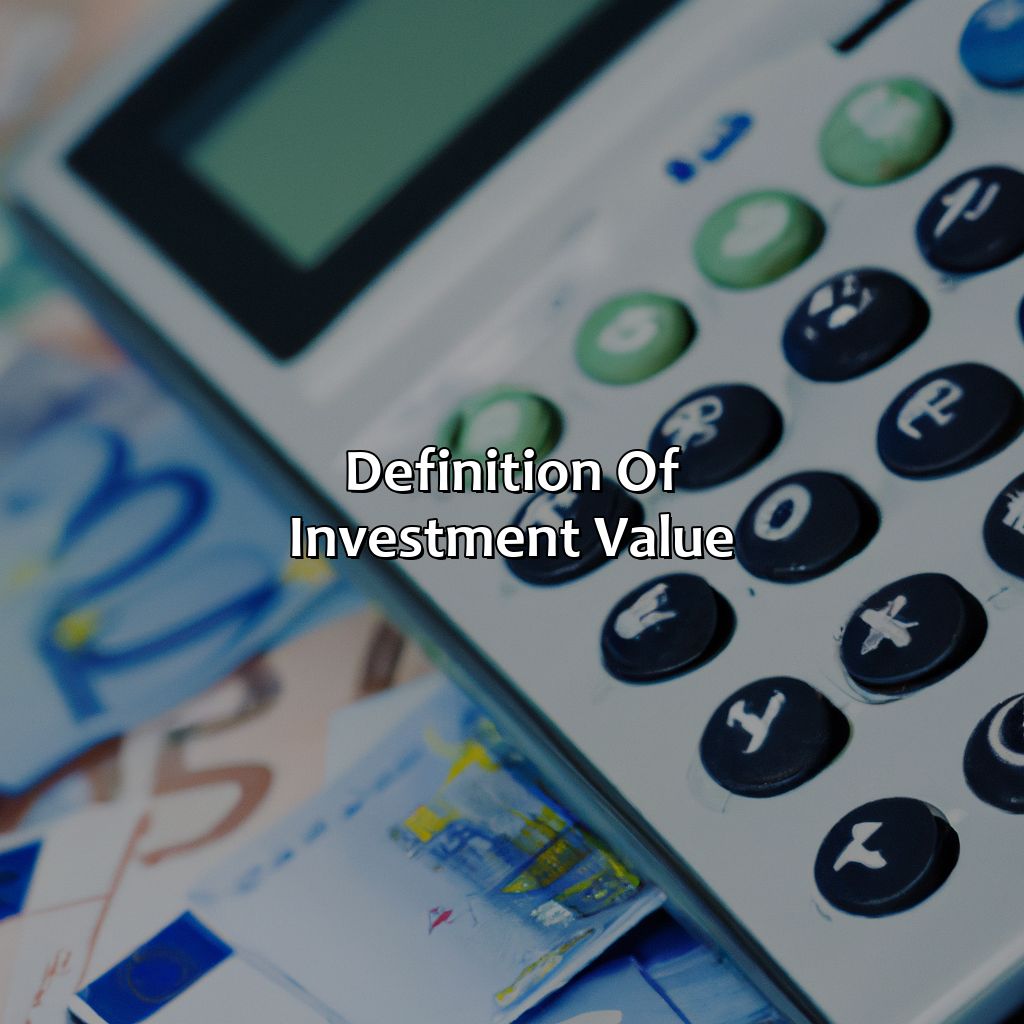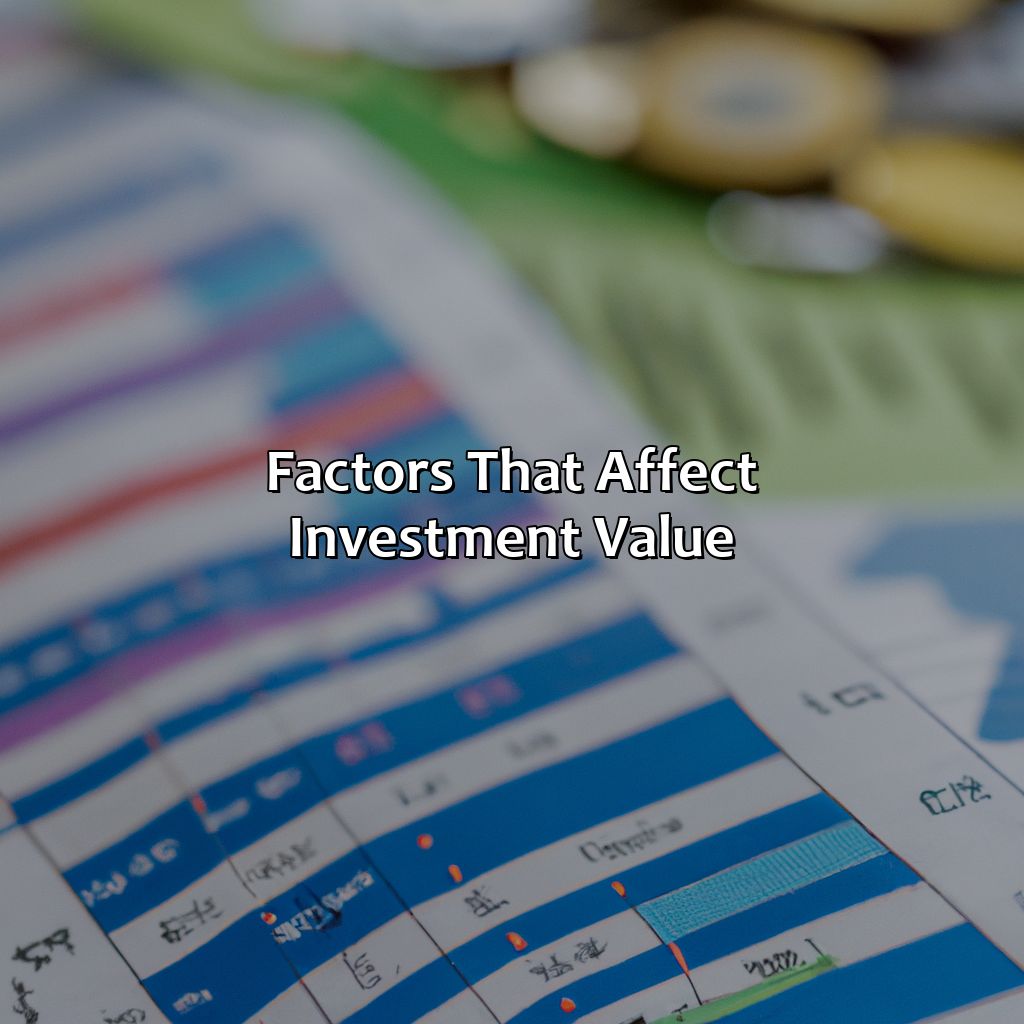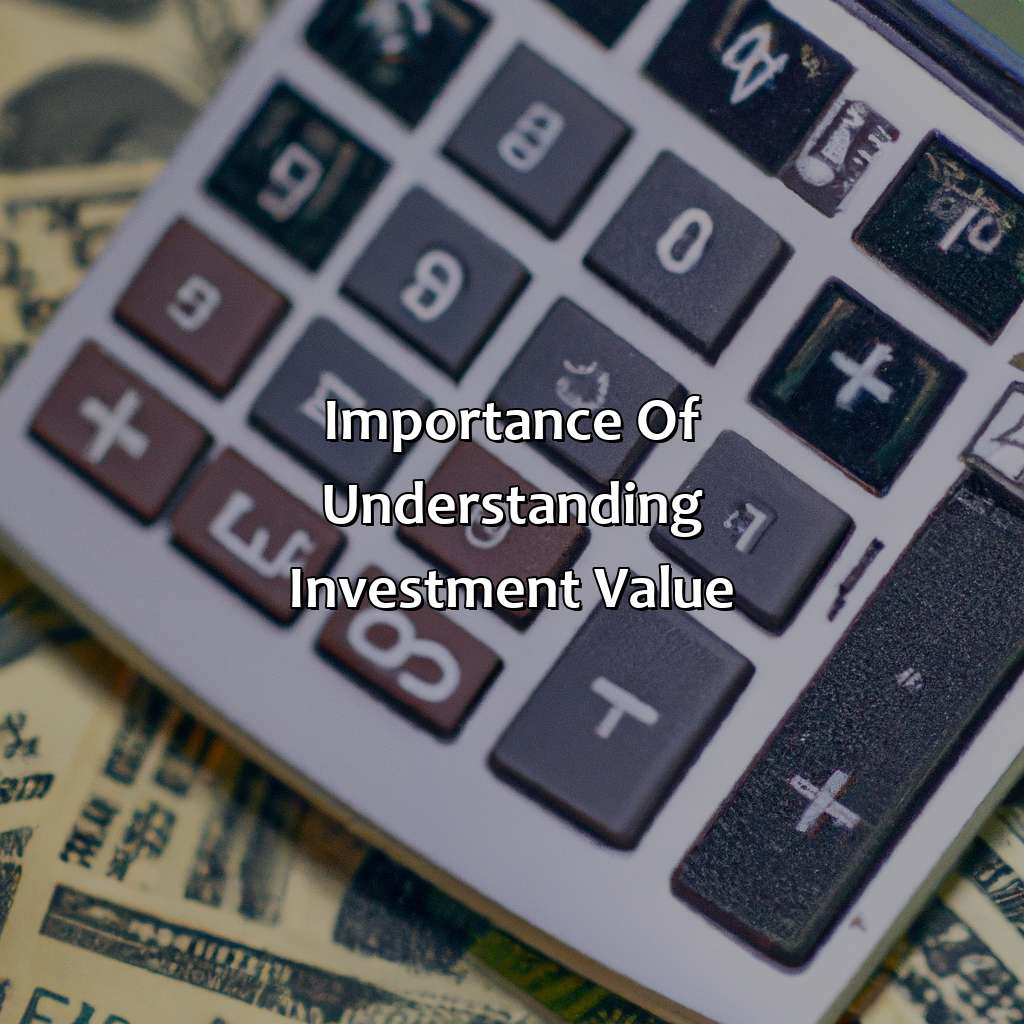How Is Investment Value Best Defined?
Key Takeaway:
- Investment value refers to the worth of an asset or security that can generate future cash flows based on market expectations and economic conditions. It is an estimate of the asset’s intrinsic value, not its current market price.
- Factors that affect investment value include economic conditions, industry trends, company performance, and market sentiment. Understanding these factors helps investors make informed decisions and mitigate risks.
- The most common methods of determining investment value are comparable company analysis, discounted cash flow analysis, asset-based valuation, and market valuation multiples. Each method has its own strengths and weaknesses, and investors should use a combination of methods to obtain a more accurate valuation.
Do you want to get the most out of your investments? Knowing the value of your investments is an essential part of investing. This article dives into how to best define investment value.
Definition of Investment Value
In the field of finance, the concept of investment value refers to the intrinsic value of an asset or security, compared to its current market value. Investment value is not just a numerical figure, but it also includes qualitative factors such as the current condition of the asset, the future prospects of the asset, and the overall market trends. The definition of investment value varies from person to person and is influenced by factors like risk tolerance, financial goals, and investment horizon. Therefore, it is important to understand the context and perspective while defining the investment value for any particular investment.
Investment value can be assessed through various methods, including the discounted cash flow (DCF) method, the capital asset pricing model (CAPM), and the earnings multiplier method. Each method has its own set of advantages and disadvantages, and the appropriate method varies depending on the type and nature of the investment being evaluated.
It is also important to consider the role of emotions in determining investment value. Investor sentiment, market rumors, and media coverage can all have a significant impact on the perceived value of an investment, regardless of its intrinsic worth. As a result, investors need to keep emotions in check and rely on data-driven analysis to make informed investment decisions.
To maximize investment value, investors should focus on diversification, risk management, and long-term planning. Diversification can help reduce the overall risk of an investment portfolio, while risk management strategies like stop-loss orders can limit losses in case of market downturns. Long-term planning, including setting clear financial goals and regularly reviewing and adjusting investment strategies, can help ensure a steady and sustainable return on investment.

Image credits: retiregenz.com by Yuval Duncun
Factors that Affect Investment Value
To get a better grasp of investment values, explore the factors that influence them. Economic conditions, industry trends, company performance and market sentiment are all vital in deciding the investment value. Below, find out how these factors can affect the worth of your investment.

Image credits: retiregenz.com by Joel Duncun
Economic Conditions
Economic indicators have a profound impact on investment value. Market conditions, inflation rates, and interest rates are some of the factors that affect the economic environment in which investors operate. To maximize benefits, potential investors must pay close attention to these variables. With rising interest rates, for example, bonds will yield higher returns while stocks become less attractive.
Investors should also keep an eye on market volatility and economic growth prospects to make meaningful decisions about their investments. Economic factors influence the funds’ performance such as mutual funds or exchange-traded funds (ETFs). The costs may rise if companies are directly affected by rising commodity prices.
Historically, the stock markets encountered several downturns when there were countries facing rising debt levels or when financial institutions experienced significant losses. Therefore, it is imperative to keep one’s ear to the ground regarding economic developments and continually monitor market shifts to make profitable investments.
Long-term investment in the tech industry is like playing a game of ‘Where’s Waldo?’– you never know where the next big thing will be hiding.
Industry Trends
As the business environment changes rapidly, understanding the pulse of the market through industry trends has become crucial for making informed investment decisions. Keeping track of current and emerging trends helps to identify growth opportunities, anticipate risks and gauge investor sentiment.
Investment decisions based on reliable industry trends can help minimize financial losses and maximize returns. By keeping up with trends like technological advancements, changing consumer preferences, and evolving government policies, investors can make informed choices regarding their portfolios. Additionally, examining deeper niche areas within industries and tracking competitive landscapes can offer unique insights into market performance.
Investors should also remain mindful that not all industry trends are created equal and not all will have a significant impact on investment value. It is important to distinguish between short-term fads versus long-term shifts in consumer behavior or macroeconomic factors.
Pro Tip: Regularly monitoring industry trade publications and financial news outlets can provide valuable information on relevant industry trends. Investments may rise and fall, but a company’s performance in the market always speaks louder than the sound of crashing stocks.
Company Performance
A crucial aspect of investment value is the performance of the company in question. Business growth, profitability, market trends, management effectiveness and operational efficiency all contribute to a company’s overall performance. This can help investors gauge whether a particular investment will be profitable or not.
An investor evaluates a company’s financial statements, cash flow, revenue generation capacity, debt servicing ability, and dividend dispersion capabilities to establish its performance. A strong performance indicates that the company has healthy fundamentals and significant potential for growth.
In addition to financial performance metrics, industry competition and the regulatory environment can affect a company’s long-term success. Therefore, it is essential for an investor to assess these external factors when evaluating a company’s investment value.
According to Forbes Magazine (2021), “The most effective tool for assessing a firm’s true worth is by analyzing its financial statements”.
Overall, understanding a company’s performance is critical to determining its investment value. By conducting comprehensive research, investors can minimize risk while maximizing returns on their investments.
Market sentiment may be a fickle mistress, but if you’re smart you won’t let her dictate your investment decisions.
Market Sentiment
Investor’s attitude and perception in the market are known as a prevailing market outlook. Market sentiment is crucial for investment decisions as it directly affects asset prices. Bullish sentiments represent optimism, leading to positive buying activities while bearish feelings indicate pessimism, leading to selling activity. Sentiments can be influenced by various factors like global macroeconomic factors, corporate profit outlook, political stability or instability, interest rate changes, or major financial events in the past. Ultimately, it determines whether the market is more likely to move up or down for future investments.
Market sentiment plays a part in pricing movement and contributes to trend identification. Hence understanding investors’ emotions requires market research and analytics based on investor surveys – whether they are positive or negative about investing can shape prospect plans through trends extrapolation. Sentiment analysis also involves identification of signals that set expectations about an upcoming event; a stock price could rise with increased demand after a positive earnings report.
Moreover, social media has become an essential platform that allows investors to read other investors’ views and comprehend market psychology patterns accurately based on human behaviour patterns.
During the 2007-08 global financial crisis, bearish tangible fears have undermined firm convictions of many seasoned investors who were caught off-guard by the sudden severity of the recession globally. However, there are signs that markets may start resuming back confidence following easing by central banks too on account of Covid-recession which caused uncertainty among markets leading to “permitted fear” amongst stockholders across sectors from Transportation, energy and utilities too Banking and airlines. Market indicators benefit analysts who try to determine security valuations and take positions depending on how these signals impact trading volumes.
Calculating investment value is like trying to predict the weather: you can use all the methods in the world, but in the end, it’s still just a guessing game.
Methods of Determining Investment Value
To work out investment value, you must study different ways. To know better, the techniques for establishing investment value through:
- Comparable company analysis,
- Discounted cash flow analysis,
- Asset-based valuation, and
- Market valuation multiples
can be used. Every way has its own features. The choice of method depends on the investment situation.

Image credits: retiregenz.com by Harry Jones
Comparable Company Analysis
To analyze comparable companies, businesses use a method called ‘Equity Analysis through Peer Comparisons’.
The following table presents the Comparable Company Analysis. It typically includes columns for:
- Name of the company
- Ticker symbol
- Enterprise value ($ million)
- Revenue ($ million)
- EBITDA ($ million)
| Company | Ticker | EV ($M) | Revenue ($M) | EBITDA ($M) |
|---|---|---|---|---|
| Company 1 | XXXX | XX | XX | XX |
| Company 2 | XXXX | XX | XX | XX |
| Company 3 | XXXX | XX | XX | XX |
| Company 4 | XXXX | XX | XX | XX |
| Company 5 | XXXX | XX | XX |
Using Equity Analysis through Peer Comparisons, investors can observe relative valuations and identify discrepancies between stock prices and actual values.
Pro Tip: Ensure to gather up-to-date financial data for accurate analysis. Trying to predict the future worth of an investment is like trying to predict tomorrow’s weather – it’s all just discounted guesswork with some fancy calculations thrown in.
Discounted Cash Flow Analysis
Valuing an investment’s present worth using its predicted cash flows, adjusted for the time value of money through a discount rate, is known as ‘Present Value of Future Cash Flows Analysis’. One version of this is the well-known ‘Discounted Cash Flow Analysis’, which is often used in investment appraisal. By converting future cash flows into their current values and then adding them up, Discounted Cash Flow Analysis helps to measure an investment’s true worth.
To carry out Discounted Cash Flow Analysis, you must first assess and predict an investment’s probable future cash flows. Then, by selecting a discount rate that represents an investor’s required rate of return on their invested capital – adjusted for risk – a calculated present value of each expected cash flow can be determined. Finally, add the discounted expected cash flows to determine the current net present value of the asset.
Although Discounted Cash Flow Analysis is well-regarded among investors and analysts due to its robustness and capacity to factor in variables specific to an investment opportunity, there are a few drawbacks to this method. For example, it requires predicting long-term cash flows from an asset over multiple years while accounting for inflation rates and interest rates’ potential changes.
Still, some practical tips can help improve Discounted Cash Flow Analysis results. First, accurately predicting income-producing assets’ daily or monthly operating expenses will aid in estimating net potential income. Second, utilizing consensus estimates from several credible financial research sources for forecasting interest rates/sales growth can help factor in economic uncertainty when creating forecasts. Finally, incorporating sensitivity analysis into your projections will assist in determining how changes in key inputs will impact your forecast results, reducing doubt and assisting with decision-making processes concerning investments.
By following these suggestions alongside accurate predictions and selecting suitable discount rates for an investment opportunity’s risk profile level during valuation methods such as the Discounted Cash Flow Analysis approach – investors can make informed decisions based on quantitative metrics instead of subjective opinions.
Calculating the value of an asset is like trying to find a needle in a haystack, but with the added risk of getting poked in the eye.
Asset-Based Valuation
Moreover, Asset-Based Valuation is commonly used when assessing distressed or bankrupt companies with undervalued assets. It can provide a floor valuation for the investment because even if all other aspects of the business fail, there is still inherent value in its assets.
An interesting fact relates that while Asset-Based Valuation can be used on any type of investment including stocks or bonds it is particularly useful for examining fixed-income securities like bonds that have principal and periodic interest payments as their primary attraction.
Market valuation multiples are like Tinder profiles – they may look attractive, but it’s best to do your due diligence before swiping right on an investment.
Market Valuation Multiples
Valuation Multiples are a determination method for calculating the worth of a business based on its relative market position and financial performance. It is fundamental to investment decisions.
A table that shows the Market Valuation Multiples and their respective metrics, such as Earnings before Interest, Taxes, Depreciation, and Amortization (EBITDA) or Price-to-Earnings ratio (P/E), can help investors compare different companies’ valuations. For instance, Enterprise Value-to-Sales is used to evaluate unprofitable businesses with insufficient earnings, while P/E Ratio is more suitable for large revenue-generating companies.
Notably, some multiples may not apply in specific industries or markets. For example, Price-to-Book ratio is irrelevant for tech firms without tangible assets. Still, Return-on-Investment Capital (ROIC) is efficient in determining performance-based value in software ventures.
Henry cautiously evaluated the valuation multiples of a pharmaceutical research company before investing his capital. Despite the rosy financial projections they presented him with at first glance, the market multiples indicated subpar earnings compared to their competitors. He decided to invest elsewhere using quantitative data-backed valuations to aid his decision-making process instead.
Investment value may be important, but understanding it is crucial- unless you want to end up drowning in debt and regret.
Importance of Understanding Investment Value
In today’s economy, it is crucial to comprehend the true meaning of investment value. Understanding the investment value is essential for both individuals and businesses to make informed investment decisions. The significance lies in comprehending the real value of an investment in terms of future cash flows, returns, and risks. It allows investors to allocate their resources to investments that are more likely to generate a higher rate of return while presenting a lower level of risk.
To determine the investment value, one must consider the investment’s intrinsic value, which is the true value of an asset, considering all relevant factors. This includes the asset’s cash flows, asset replacement costs, market demand, and competition. Investors must avoid overvaluing or undervaluing their investments, as this can lead to inaccurate decision-making and financial losses.
It is also essential to note that the investment value may vary based on the individual’s or business’s investment goals and risk tolerance. What may be a good investment for one person may not be suitable for another. Therefore, investors must evaluate their investment objectives and tailor their investments accordingly.
Pro Tip: Conduct thorough research and analysis before making an investment decision to determine its real value. Seek a professional’s assistance in identifying factors that may impact the investment’s value and predicting future cash flows.

Image credits: retiregenz.com by Yuval Washington
Five Facts About How Is Investment Value Best Defined:
- ✅ Investment value is determined by the expected future cash flows generated by the asset. (Source: Investopedia)
- ✅ Investment value differs from market value, which is the price at which the asset would sell in the current market. (Source: The Balance)
- ✅ The determination of investment value is subjective and may vary based on individual investment objectives and risk tolerance. (Source: Financial Times)
- ✅ Factors affecting investment value include economic conditions, company performance, and market trends. (Source: Entrepreneur)
- ✅ The use of valuation models, such as discounted cash flow analysis and comparables analysis, can help in determining investment value. (Source: Forbes)
FAQs about How Is Investment Value Best Defined?
How is investment value best defined?
Investment value can be defined as the potential future monetary return on an investment, taking into account the investor’s individual financial goals and risk tolerance.
What factors determine investment value?
Several factors can affect investment value, including the current market conditions, the company’s financial health, the investor’s time horizon, and their investment strategy.
How does risk affect investment value?
Risk is a crucial factor in investment value, as it affects the potential return on investment. Higher-risk investments generally have the potential for higher returns, but also come with a higher chance of loss.
What role does diversification play in investment value?
Diversification can help minimize risk and maximize investment value by spreading an investor’s funds across multiple assets and markets, reducing the impact of any one investment’s performance.
What are some common methods for determining investment value?
Some popular methods for determining investment value include fundamental analysis, technical analysis, and market valuation methods such as price-to-earnings ratios and enterprise value.
How can an investor maximize investment value?
An investor can maximize their investment value by doing the necessary research, diversifying their portfolio, regularly reviewing their investments, and seeking the advice of a financial professional.
